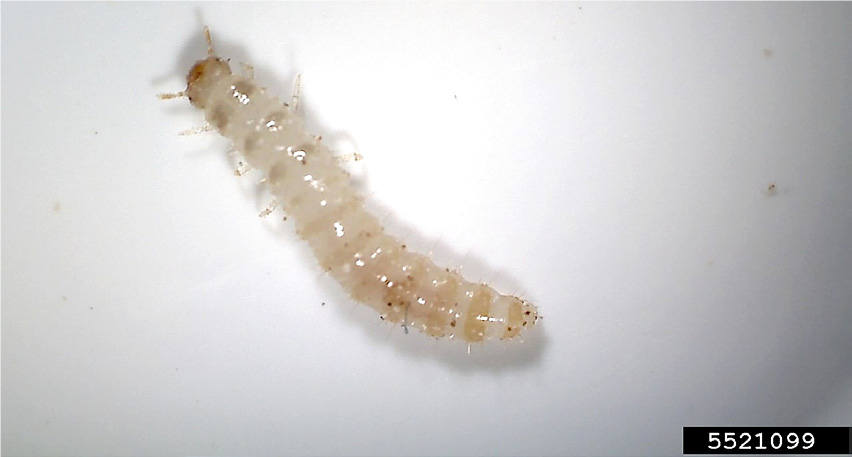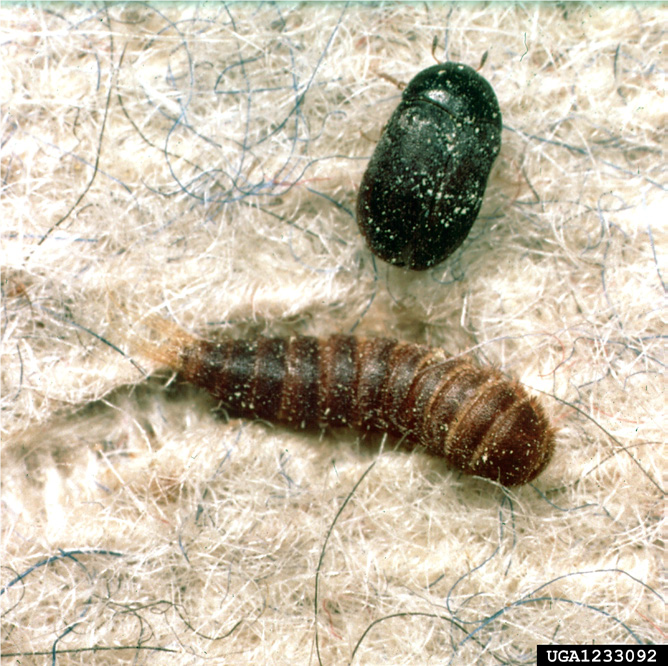Our kitchens contain an array of stored food items that serve as welcoming habitats for many insect pests, commonly referred to as “pantry” or “kitchen” pests. These include beetles and moths that are capable of infesting and destroying a variety of dried foods. Since many dried food items are only used occasionally, they spend a long time sitting on the shelf inviting would-be invaders to take permanent residence.
The eggs, larvae, or adults of such pests are usually brought into homes accidentally in infested products from food markets. The pests then spread to other products on shelves. However, infestations are usually not discovered until homeowners witness small beetles or worms crawling across counter tops, webs in oatmeal, the cast skins of larvae under the sink or in cupboards, or moths flying around the kitchen. By then, the invaders could be well-established and could cause considerable damage if not eliminated.
Stored Food Pests
A variety of insects infest our stored foods, but the most common in New Hampshire are the saw-toothed grain beetle, confused flour beetle, dermestid beetles, and Indian meal moth. A description of each of these pests follows. Other less common pests include the Mediterranean flour moth, foreign grain beetles, rice weevils, cigarette, and drug store beetles, and spider beetles. They all generally feed on the same foods and have similar control measures.
Sawtoothed Grain Beetle
The sawtoothed grain beetle (Oryzaephilus surinamensis), our most common kitchen pest, is a slender, flat, brown beetle approximately 1/10” long. It gets its name from the six saw-tooth-like projections on either side of its thorax (body mid-section). Both the larvae and the adults feed on a variety of dried foods. Adults live an average of six to ten months, but may live as long as three years. Eggs are laid in food and hatch in three to five days. The resulting larvae mature in about two weeks, then pupate and emerge as adults in about one week. The life cycle from egg to adult takes approximately three to four months.


Confused Flour Beetle
The confused flour beetle (Tribolium confusum) is a reddish-brown beetle about 1/7” long with minute punctures on its head and thorax and ridges on its hind wings. Its life cycle is similar to the saw-toothed grain beetle except the average confused flour beetle lives about one year and its life cycle takes about six months.

Carpet Beetles
Dermestid beetles, as a group, are best known as scavengers that feed on animal matter such as hides and wool products. Several species, including the black carpet beetle (Attagenus unicolor), varied carpet beetle (Anthrenus verbasci), and larder beetle (Dermestes lardarius) feed on a variety of stored foods and are common kitchen pests. The larvae are very destructive and are readily recognized by long hairs or tufts of hair protruding from their body. They vary in color from brown to almost black and in size and shape depending on the species. The adults also vary in size and color depending on the species.



Indian Meal Moth
The Indian meal moth (Plodia interpunctella) is the most common moth species in New Hampshire kitchens. The adult moth has a wing span of about 3/4” and its forewings are banded whitish-gray and copper. The eggs are laid on stored foods and hatch into small whitish larvae within a few days. The larvae feed on pantry food and spin webs as they crawl around. This webbing is often the first evidence of an infestation. Their life cycle is completed in six to eight weeks.



Management of Stored Food Pests
IPM Strategies:
• Food Salvage - If the problem is discovered early (before food becomes badly infested), measures can be taken to salvage food through heat or cold treatment. Spread the contents out on a tray and heat in an oven at 130F for 30 minutes, or place in a deep freeze at 0F for four days. Repackage in tightly closed containers such as glass jars or cans. Badly infested food should be destroyed or disposed of by sealing the containers and placing in the garbage. Many stored product pests can easily chew through plastic or cardboard containers, so materials that are stored for a long time should be in air tight glass or plastic containers. This also limits new infestation by keeping food odors from reaching insects outside the containers.
• Sanitation - Good sanitation is important to prevent infestations. Spilled food that gets into cracks, under sinks, refrigerators, and dishwashers, and behind drawers will harbor insects and keep an infestation going. Periodic cleaning and vacuuming will help discourage an infestation from spreading should you accidentally bring these pests into your home.
• Chemical Control - Chemical control may become necessary when the infestation has spread to several food items and has undoubtedly gotten into cracks and remote areas of the kitchen. Remove all food and kitchenware from the shelves and clean thoroughly using a vacuum.
Consult your county Agricultural Field Specialist for specific pesticide recommendations.
Spilled Food Pests
A number of insects feed on spilled food and debris that work their way into cracks, crevices, behind kitchen appliances or under sinks and cabinets. The most common pests are ants, cockroaches, silverfish, and carpet beetles.
Ants
The large black carpenter ant (Campanotus pennsylvanicus), three other species of carpenter ants, and various red, brown or black ants are attracted to sweets and other food found in kitchens. They often come in from nests located outdoors in the ground or under the foundation. Control is best achieved by eliminating food sources and by judicious spot treatments at entrance sites and along ant routes. If the ant nest is located within the house structure, it is necessary to destroy it. Carpenter ants strongly prefer wet or damp wood in which to make their nests.

Cockroaches
Our most common kitchen cockroach is the German cockroach (Blattella germanica), which is slightly over 1/2” long and is brown, with two black parallel lines just behind its head. It matures in 40 days and multiplies throughout the year. Less common cockroaches are the American (Periplaneta americana), Oriental (Blatta orientalis), and brown-banded (Supella longipalpa) cockroaches. In New Hampshire we also have a recent immigrant, the dusky cockroach. It lives outdoors, but is attracted to lights and occasionally appears indoors. It is not a pest. (Blattella germanica), which is slightly over 1/2” long and is brown, with two black parallel lines just behind its head. It matures in 40 days and multiplies throughout the year. Less common cockroaches are the American (Periplaneta americana), Oriental (Blatta orientalis), and brown-banded (Supella longipalpa) cockroaches. In New Hampshire we also have a recent immigrant, the dusky cockroach. It lives outdoors, but is attracted to lights and occasionally appears indoors. It is not a pest.



Silverfish and Firebrat
Both silverfish (Lepisma saccharina) and firebrat (Thermobia domestica) can be found in kitchens as well as other parts of the house from the basement to the attic. In addition to spilled foods, silverfish and firebrat feed on wallpaper paste, book bindings, rayon fabrics, and starched clothing. Firebrat is found in warmer places (98-102F), such as furnace rooms, while silverfish inhabits cooler (72 - 80F) portions of the house such as kitchens, bathrooms, and attics. They are silver-gray to greenish-gray in color with three tail-like structures at the end of their body.


Management of Spilled Food Pests
IPM Strategies:
• Sanitation - Good sanitation is important to prevent infestations. Reduce the food supply of these pests by removing spilled food and debris. Use a vacuum cleaner to clean the hidden places behind appliances, sinks, and in cupboards.
• Mechanical Control - To prevent entry, seal or caulk all cracks in walls, around baseboards, water pipes, and windows.
• Chemical Control - Consult your county Agricultural Field Specialist for specific pesticide recommendations. Do not contaminate food or feed. When you discover an infestation, thoroughly search all of your stored products. You may discover infestations in places you did not expect, like wreaths of dried fruit, pet food, or ornamental ears of corn.
Stop! Read the label on every pesticide container each time before using the material. Pesticides must be applied only as directed on the label to be in compliance with the law. Contact the Division of Pesticide Control at (603) 271-3550 to check registration status. Dispose of empty containers safely, according to New Hampshire regulations.
Download the resource for the complete fact sheet.

